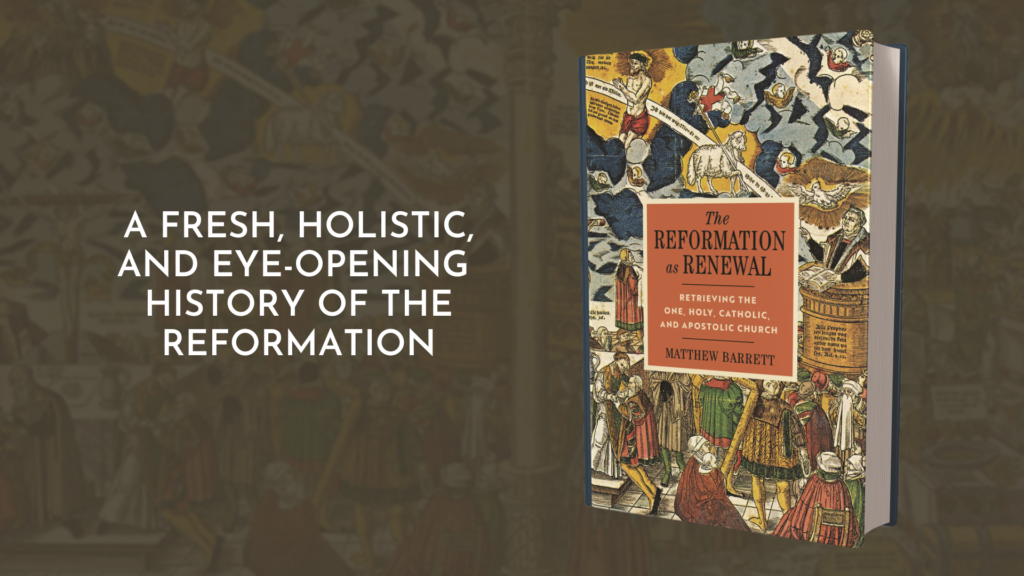
Demythologizing the Reformation
In celebration of Reformation Day this week, we have invited Timothy George to share some thoughts. The following is his Afterword to Matthew Barrett’s book, The Reformation as Renewal: Retrieving the One Holy Catholic and Apostolic Church, which is on sale this week only. George helpfully challenges us to see more of the Reformation by “exploding” three specific myths that obscure the reality of what transpired.
In 2017, in commemoration of the 500th anniversary of the Protestant Reformation, I was asked by the journal Modern Age to write an essay titled “What the Reformers Thought They Were Doing.” What did they consciously aim at? What motivated their labors and struggles? What made them tick? Hardly anyone nowadays studies the Reformation with such questions in mind. In the past half-century, social, economic, and political history have dominated the field. Important research has been done on “reforming from below” as groups formerly marginalized in much of Reformation historiography have come into the limelight—women, peasants, dissenters, Jews, and others. We have studied the Reformation of the cities, the Reformation of the refugees, the Reformation of “the common man,” and so on. We have also looked at the Reformation through the lenses of our postmodern masters—Marx, Freud, Darwin, and Nietzsche. And who can deny that these recent historical strategies have yielded impressive insights and much information? We know much more now than we did when I first set out as a young scholar to study the Reformation, with Roland Bainton’s Here I Stand in one hand and Calvin’s Institutes in the other. We know more, but do we perhaps see less?
If we are to understand what the Reformers thought they were doing, we need a vigorous program of demythologization. In particular, three myths about the Reformation should be exploded.
(1) “The Reformation divided the church.” This old chestnut is the starting point for many Reformation histories published since 2017. But the rupture of Western Christendom did not begin in the sixteenth century. There was the split between East and West in 1054, the Babylonian Captivity (1309–77), followed by the Western schism (1378–1417), Lollard dissent in England, Hussite wars in Bohemia, the Waldensians in France and Italy, the Alumbrados in Spain. Division of the church was not the outcome of the Reformation but rather its starting point.
(2) “Luther was the first modern man.” Adolf von Harnack, the champion of German liberal Protestantism, gave voice to this myth when he wrote in 1923: “The modern age began along with Luther’s Reformation on 31 October 1517; it was inaugurated by the blows of the hammer on the doors of the castle church at Wittenberg.”2 In this vein, Luther becomes the forerunner of everything desirable in the modern world, from individualism and political freedom to pretzels and peanut butter, which, they say, go good with German beer. The shadow side of this myth is to blame everything negative in the modern world, everything from nationalism to Nazism, on the monk of Wittenberg.
(3) “The Reformation was a German event.” This myth was not even true in the sixteenth century when the message of the Reformers spread across the entire continent of Europe, from Lisbon to Lithuania, far beyond the space between the Elbe and the Rhine. Today, in an era of globalism and decolonization, the faith of the Reformers is more fervently and faithfully articulated in the majority world south of the equator rather than it is in the staid, withering Christianities of old Europe and North America.
In this impressive, sweeping study, Matthew Barrett helps dispel these and other myths as he offers us a fresh, contextual telling of the Reformation story. By context here, he means more than the years just before and just after the central events of the sixteenth century, in other words the late Middles Ages and early modernity. The context of the Reformation, largely understood, is the entire history of the people of God through the ages. Originality and innovation were not the agenda of the Reformers. They had no desire to leave the true catholic church, much less to start a new one. What the Reformers aimed for was the renewal of the one, holy, catholic, and apostolic church on the basis of the Word of God. What the Reformers thought they were doing was calling this church back to its true scriptural and evangelical origins—ad fontes! What they thought they were doing was presenting anew the gospel of God’s free, unfettered grace in life and work of Jesus Christ, a gospel of real grace for real sinners. As Luther put it, “God does not save people who are only fictitious sinners. Be a sinner and sin boldly, but believe and rejoice in Christ even more boldly, for he is victorious over sin, death, and the world.”

